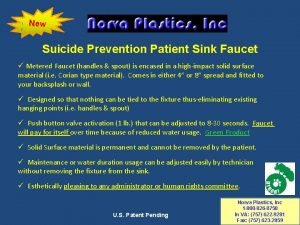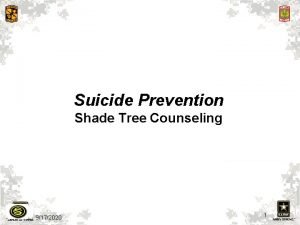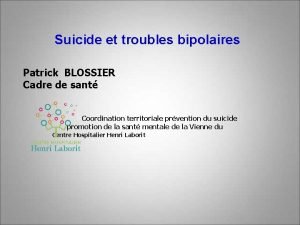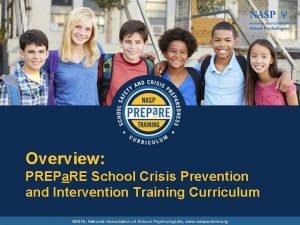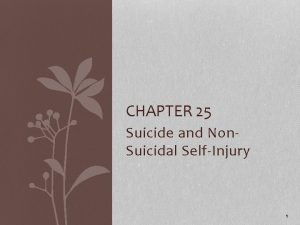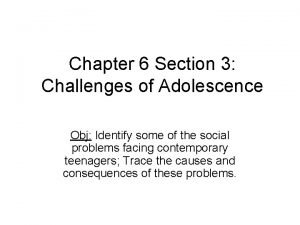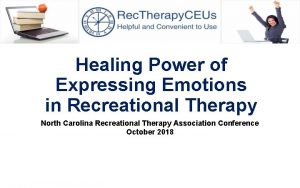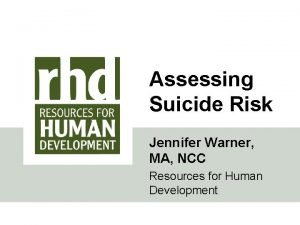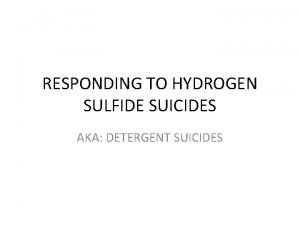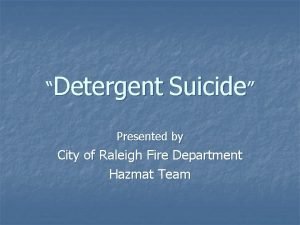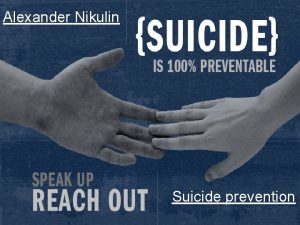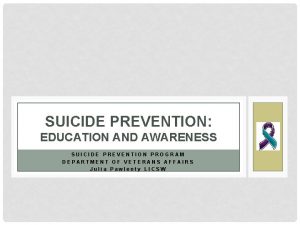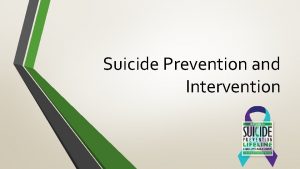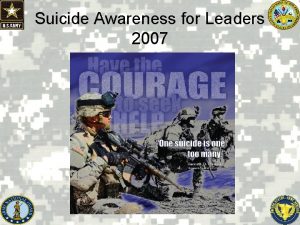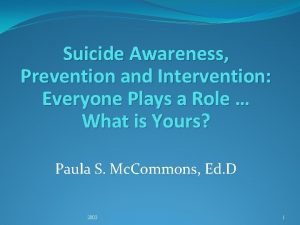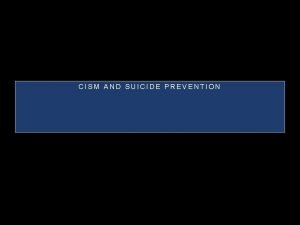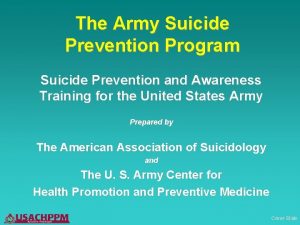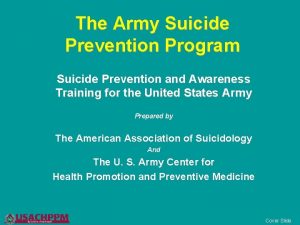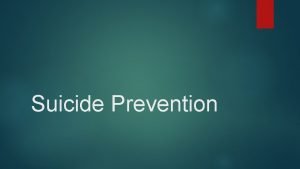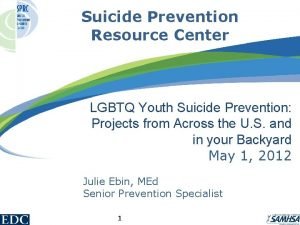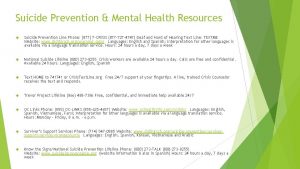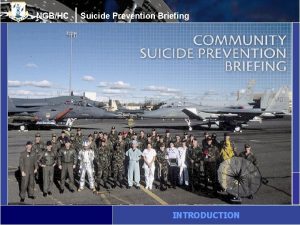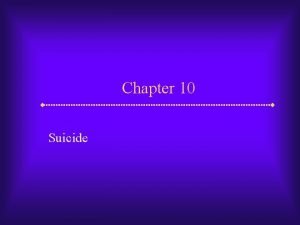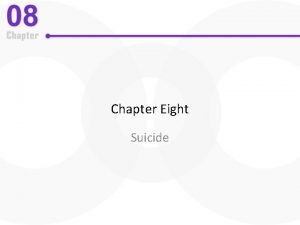Suicide Intervention and Prevention 1 Suicide Awareness and






























- Slides: 30

Suicide Intervention and Prevention 1

Suicide Awareness and Intervention Seminar Overview Suicide Defined Assessment Intervention Prevention What If 2

SUICIDE: “a permanent solution to a temporary problem” 3

FACTS AND FABLES ABOUT SUICIDE 4

ASSESSMENT SUICIDAL CLUES SUICIDAL POTENTIAL RISK ASSESSMENT 5

SUICIDAL CLUES CHANGE IN FEELINGS n n n n Overwhelmingly Sad Worthless Hopeless Lonely Helpless Guilty Lack of interest Extreme mood 6

SUICIDAL CLUES Change in Thoughts n n n “I wish I’d never wake up again” “I won’t be needing these things anymore. ” “Nothing I do seems to matter anymore. ” n n n “No one can do anything to help me now. ” “My spouse would be better off if I were dead. ” “I hate my life. I hate everyone and everything. ” 7

SUICIDAL CLUES Change in Actions n n n Social Withdrawal Behavior Extremes Giving Away Possessions Alcohol/Drug abuse Self-mutilation Dwelling on problems n n n n Excessive crying Easily agitated No energy/inactive Excessive risk taking behavior Putting things in order Access to weapons Sudden recovery 8

SUICIDAL CLUES Physical Changes Lack of interest in appearance n Change/loss of sex drive n Disturbed sleep n Change/loss of appetite n 9

SUICIDAL POTENTIAL Always anticipate suicide if there have been previous attempts n Always anticipate suicide in a disturbed person. n Has there been a loss? n Has there been a change in interests, life style, sleeping or eating habits, or the giving away of valued possessions? n 10

SUICIDAL POTENTIAL Is there a feeling of hopelessness/helplessness/ worthlessness? n Is there drug or alcohol abuse? n Has there been an incident of social disgrace/humiliation? n Is there an anniversary date of a personal tragedy? (i. e. . . , death or divorce) n 11

SUICIDE ASSESSMENT -----Low Risk -low lethality -no history of suicide attempts -no complete plan of action or rescue -desire change from internal pressures -----No Risk -no plan of action -no history -no attempts 12

SUICIDE ASSESSMENT -----High Risk -high lethality -history of suicide attempts -severe personal difficulties -desire death or death wish -no rescue plan -----Moderate Risk -high lethality -some plan of action and rescue -may have history of attempts 13

INTERVENTION The ABC Approach of Helping 14

ACHIEVE RAPPORT 3 Critical rules: listen, listen! What is the person feeling? Determine if an emergency exists. Is the person thinking about suicide now? Has the person decided to commit suicide? Does the person have the means? How specific are the plans? How lethal? 15

BREAK THE PROBLEM DOWN An Emergency -- No time to waste! Evaluate immediate needs and resources. Assess the Lethality. Assess the intervention potential. (Willing to go to the hospital? ) 16

BREAK THE PROBLEM DOWN (Cont. ) A Possibility -- Time to explore the suicide risk. Explore the problem through active listening. Encourage the person to talk in detail. Let person prioritize desired changes. Seek Alternatives/Review Resources 17

CHALLENGE TO ACTION n Help the person to look at his/her own coping skills. n Explore the “will to die” and the “will to live. ” Hear their pain Nurture the ambivalence toward life. n Help the person to discover his/her own way to cope with life. 18

CHALLENGE TO ACTION Cont. n Encourage the person to see a trained professional. Seek and involve professional help immediately if the suicide is intense. n “Contract” with the person for future Contacts. 19

SUICIDE INTERVENTION: DO’S n n Do listen! Do accept the person’s feelings. Do take the person seriously. Do accept the emotional state the person is in n Do ask for the reasons for not wanting to live. Do ask why s/he has chosen to stay alive thus far. Do show you care by listening and accepting. 20

SUICIDE INTERVENTION: DO’S (Cont. ) Do accept the life perspective as stated. n Do be understanding. n Do suggest that you help the person find someone that can help him/her. n 21

STRESS REDUCTION n n n EXERCISE REGULARLY EAT RIGHT GET ENOUGH SLEEP LIMIT USE OF ALCOHOL USE TIME WISELY 22

STRESS REDUCTION Cont. n n n Work out anger Have a good laugh Go for a walk Develop a hobby Learn a relaxation technique Practice your faith 23

“Buddy Care” Be alert to factors that may cause stress in your co-workers. Know your team! Be caring and patient and express your concern 24

“Buddy Care” Cont. Use effective communication techniques: Listen! Be accepting. Continue to listen! Observe non-verbal cues. Keep on listening! 25

“Buddy Care” Cont. Take action. Determine suicide potential. Make referral to an appropriate professional. DO NOT LEAVE THE INDIVIDUAL ALONE UNTIL YOU ARE CERTAIN SHE/HE IS IN THE CARE OF SOMEONE TRAINED TO HELP OR THAT THE CRISIS IS RESOLVED! 26

PREVENTION FOUR LINES OF CARING FIVE STEPS 27

PREVENTION FOUR LINES OF CARING 1. “Buddies”, immediate family, relatives & friends 2. Contact with front-line resources 3. Mental Health/Chaplain 4. Hospital 28

PREVENTION FIVE STEPS 1. Establish Relationship 2. Identify Problem 3. Evaluate 4. Assess 5. Formulate a Plan 29

? F I T WHAT IF? A H W WH AT CAN WE PREVEN T THEM ALL? IF? WH F? I T AT A H W IF? 30
 Primary prevention secondary prevention tertiary prevention
Primary prevention secondary prevention tertiary prevention Mad acronym suicide prevention
Mad acronym suicide prevention Chapter 5 lesson 3 suicide prevention
Chapter 5 lesson 3 suicide prevention Suicide chain teach
Suicide chain teach Texas suicide prevention symposium
Texas suicide prevention symposium Suicide prevention sink
Suicide prevention sink Army suicide prevention situational questions
Army suicide prevention situational questions Prévention du suicide
Prévention du suicide Suicide prevention month quotes
Suicide prevention month quotes Army suicide prevention training
Army suicide prevention training Vivien blossier
Vivien blossier School crisis prevention and intervention
School crisis prevention and intervention Privacy awareness and hipaa awareness training cvs
Privacy awareness and hipaa awareness training cvs Chapter 25 suicide and nonsuicidal self injury
Chapter 25 suicide and nonsuicidal self injury Como ser una suicide girl
Como ser una suicide girl The citadel counseling center
The citadel counseling center Youth suicide research consortium
Youth suicide research consortium Bill nye the science guy butterfly life cycle
Bill nye the science guy butterfly life cycle Kode icd 10 keracunan baygon
Kode icd 10 keracunan baygon Egoistic suicide
Egoistic suicide Suicide cuts across all social categories
Suicide cuts across all social categories Why people die by suicide joiner
Why people die by suicide joiner Loudoun county student suicide
Loudoun county student suicide Break up suicide
Break up suicide Suicide inhibitor
Suicide inhibitor Digestive enzymes and their functions table
Digestive enzymes and their functions table Dr. spock's son committed suicide
Dr. spock's son committed suicide Slap suicidality
Slap suicidality Detergent suicide ingredients
Detergent suicide ingredients Dr. thomas jentges suicide
Dr. thomas jentges suicide Detergent suicide
Detergent suicide





